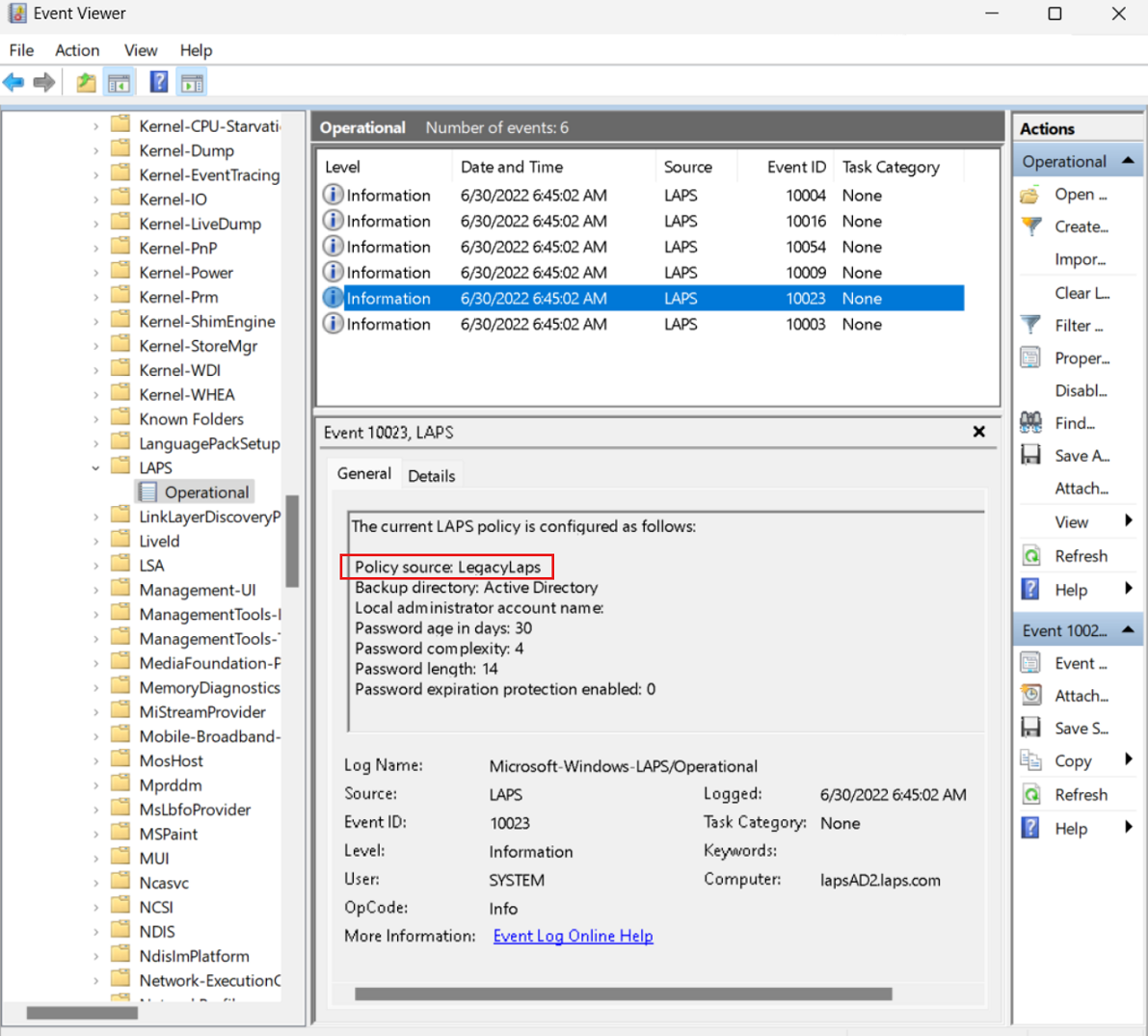Get started with Windows LAPS in legacy Microsoft LAPS emulation mode
You can set up Windows Local Administrator Password Solution (Windows LAPS) to honor legacy Microsoft LAPS Group Policy settings, but with some restrictions and limitations. The feature is called legacy Microsoft LAPS emulation mode. You might use emulation mode if you migrate an existing deployment of legacy Microsoft LAPS to Windows LAPS.
Like Microsoft LAPS, emulation mode supports storage of passwords in Windows Server Active Directory only in clear-text form. To increase security, we recommend that you migrate to using Windows LAPS natively so that you can take advantage of password encryption.
Setup and configuration
When you configure Windows LAPS in legacy Microsoft LAPS emulation mode, Windows LAPS assumes that your Windows Server Active Directory environment is set up to run legacy Microsoft LAPS. For more information about legacy Microsoft LAPS configuration, see the legacy Microsoft LAPS documentation.
Requirements and limitations
The following requirements and limitations apply to legacy Microsoft LAPS emulation mode support:
Windows LAPS doesn't support adding the legacy Microsoft LAPS Windows Server Active Directory schema.
You must install legacy Microsoft LAPS on a domain controller or another management client to extend your Windows Server Active Directory schema with the legacy Microsoft LAPS schema elements. Use the
Update-AdmPwdADSchemacmdlet to extend the schema. The Windows LAPSUpdate-LapsADSchemacmdlet doesn't add the legacy Microsoft LAPS schema elements.Windows LAPS doesn't install the legacy Microsoft LAPS Group Policy definition files.
To define and administer legacy Microsoft LAPS group policies, you must install legacy Microsoft LAPS on a domain controller or another management client.
Windows LAPS doesn't support managing legacy Microsoft LAPS Active Directory access control lists (ACLs).
To manage the legacy Microsoft LAPS Windows Server Active Directory ACLs, you must install legacy Microsoft LAPS on a domain controller or another management client. For example, to use the
Set-AdmPwdComputerSelfPermissionscmdlet.No other Windows LAPS policies can be applied to the machine.
If a Windows LAPS policy is present on the machine, it always takes precedence, regardless of how it was applied (configuration service provider, Group Policy Object, or raw registry modification). If a Windows LAPS policy is present, a legacy Microsoft LAPS policy is always ignored. For more information, see Windows LAPS policy settings.
Legacy Microsoft LAPS must not be installed on the machine.
This restriction avoids a scenario in which Windows LAPS and legacy Microsoft LAPS simultaneously try to manage the same local administrator account. Having two entities manage the same account is a security risk and isn't supported.
For the emulation feature, legacy Microsoft LAPS is considered installed if the legacy Microsoft LAPS Group Policy Client Side Extension (CSE) is installed. To detect the extension, query the
DllNameregistry value under this registry key:HKLM\Software\Microsoft\Windows NT\CurrentVersion\Winlogon\GPExtensions\{D76B9641-3288-4f75-942D-087DE603E3EA}When the DllName value is present and the value refers to a file on disk (the file isn't loaded or otherwise verified), legacy Microsoft LAPS is considered to be installed.
The Windows Server Active Directory Users and Computer management console doesn't support reading or writing legacy Microsoft LAPS schema attributes.
Windows LAPS always ignores a legacy Microsoft LAPS policy when Windows LAPS is configured on a Windows Server Active Directory domain controller.
All Windows LAPS policy knobs that aren't supported in a legacy LAPS policy default to their disabled or default settings.
For example, when you run Windows LAPS in legacy Microsoft LAPS emulation mode, you can't configure Windows LAPS to do tasks like encrypt passwords or save passwords to Microsoft Entra ID.
If all these constraints are satisfied, Windows LAPS honors legacy Microsoft LAPS Group Policy settings. The specified managed local administrator account is managed identically to how it's managed in legacy Microsoft LAPS.
Disabling legacy Microsoft LAPS emulation mode
Windows LAPS has an important difference to be aware of when planning a deployment or migration from legacy Microsoft LAPS. Windows LAPS is always present and active once a device has been joined to either Microsoft Entra ID or Windows Server Active Directory. Installation of the legacy Microsoft LAPS CSE is often used as a mechanism to control when the legacy Microsoft LAPS policy is enforced. As a built-in Windows feature, Windows LAPS starts enforcing a legacy Microsoft LAPS policy as soon as it's applied to the device. Such immediate enforcement may be disruptive, for example if enforcement occurs during the setup and configuration workflow for a new operating system.
To prevent such potential disruption, you can disable legacy Microsoft LAPS emulation mode by creating a REG_DWORD registry value named BackupDirectory under the HKLM\Software\Microsoft\Windows\CurrentVersion\LAPS\Config key and set it to the value zero (0). Setting this value prevents Windows LAPS from entering legacy Microsoft LAPS emulation mode, regardless of whether the legacy Microsoft LAPS CSE is installed or not. This value may be used temporarily or permanently. When a new Windows LAPS policy is configured, that new policy takes precedence. For more information on the Windows LAPS policy precedence ordering, see Configure Windows LAPS policy settings.
Limited administrative support
The Get-LapsADPassword cmdlet supports retrieval of the legacy Microsoft LAPS password attribute (ms-Mcs-AdmPwd). The Account and PasswordUpdateTime fields in the resulting output are always blank. For example:
PS C:\> Get-LapsADPassword -Identity lapsAD2 -AsPlainText
ComputerName : LAPSAD2
DistinguishedName : CN=LAPSAD2,OU=LapsTestOU,DC=laps,DC=com
Account :
Password : SV6[y1n3JG+3l8
PasswordUpdateTime :
ExpirationTimestamp : 7/31/2022 12:43:10 PM
Source : LegacyLapsCleartextPassword
DecryptionStatus : NotApplicable
AuthorizedDecryptor : NotApplicable
The Set-LapsADPasswordExpirationTime cmdlet doesn't support expiring or modifying the legacy Microsoft LAPS password expiration attribute (ms-Mcs-AdmPwdExpirationTime).
The Windows LAPS property page in the Windows Server Active Directory Users and Computers management console doesn't support displaying or administering legacy Microsoft LAPS attributes.
Logging
When Windows LAPS runs in legacy Microsoft LAPS emulation mode, a 10023 event is logged to detail the current policy configuration:

Otherwise, the same events logged by Windows LAPS when it doesn't run in legacy Microsoft LAPS emulation mode are also logged when it runs in legacy Microsoft LAPS emulation mode.
See also
This article doesn't go into detail about managing other aspects of legacy Microsoft LAPS. For more information, see the legacy Microsoft LAPS documentation on the download page: